Insights from Abby Le Marchand: Shaping the Future at the Design Insider AI Forum
Get ready for an industry-defining moment at the Design Insider AI Forum, an unparalleled half-day event that promises to drive forward the conversation on the use of AI by commercial interior designers and suppliers! Held at Gresham, 28 St John’s Lane, Clerkenwell, this forum is a must-attend event on the 28th of March, 2024, from 2pm to 7pm, offering an immersive journey into the innovative intersections of AI and design.
During Design Insider’s AI Forum, Abby Le Marchand, Associate Principal at HLW, will share her insights on integrating AI design innovation and strategic thinking in the commercial sector with her fellow panellists Stefano Casati, Managing Director & Principal Architect at Imagine by Casati, and Charlie Keitch, Industrial Designer and Brand Management at Jones & Partners. Abby’s perspectives will be invaluable, illuminating the potential of AI to enhance creativity and streamline design processes in the commercial sector.
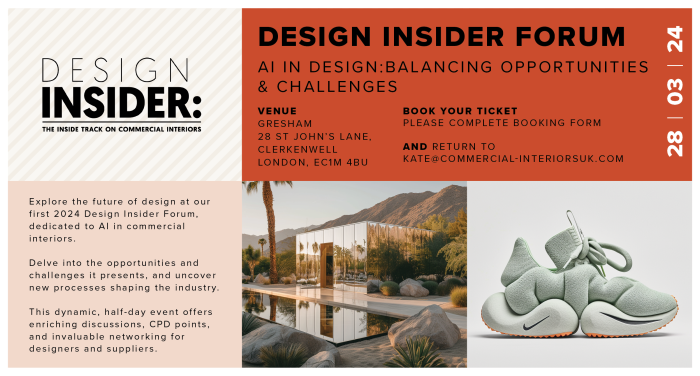
Ahead of this exciting event, we had the pleasure of speaking with Abby Le Marchand about her experience with AI at HLW, a firm that has been at the vanguard of architecture and design since 1885. Known for questioning the norm and building what’s next, HLW combines elegant aesthetics with cutting-edge technologies, making it a pioneer in integrating AI into innovative design solutions.

Abby Le Marchand, Associate Principal at HLW
Don’t miss this opportunity to gain valuable CPD points, expand your professional network, and unlock new avenues for leveraging AI in your design practice. Book your ticket now for an afternoon of enlightening discussions and invaluable learning experiences at the Design Insider Forum. Be part of the conversation that’s shaping the future of our industry 👉 Click HERE
Can you share how your studio approaches the integration of new technologies, particularly AI, in your design process?
At HLW, we have an incredible technology and innovation team that continually explores new technologies to enhance and optimise our processes. They assess our needs, explore what’s out there, and then test new tools to gauge their value and potential for implementation into our design practices. If something doesn’t exist that meets our needs, they instead customise or build tools to achieve our aims. Once a new tool is introduced, they facilitate training sessions and monitor how they’re being used. It’s a circular process, but one that means we can constantly advance our use of technology in ways that are meaningful and effective.
It’s important to ensure that technology facilitates our processes and workflows to help our team adopt new software. If it’s too different from what people know, they tend to revert to what’s familiar. I see technology as a tool to help designers explore and expand the creative process, not to replace human craft.
When it comes to AI, our team has been exploring both generative AI (iterative tools that require prompts to generate results) as well as predictive AI (input data and complete analysis to predict outcomes). We’ve mostly been testing generative AI tools including Midjourney, Stable Diffusion, Chat GPT and the Adobe Suite.
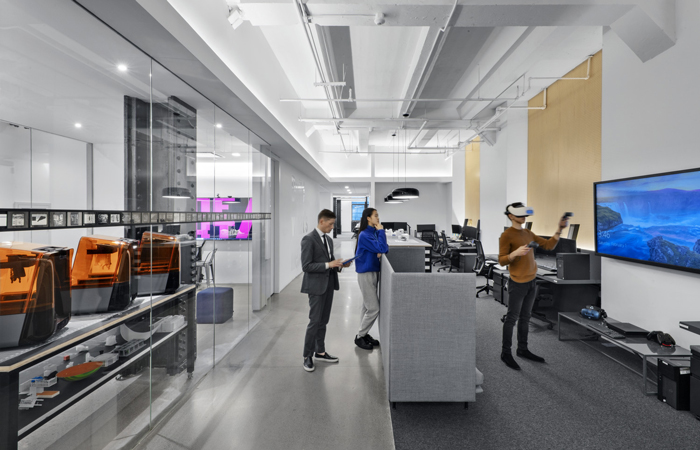
How do you see AI influencing the design and commercial sector? Are there specific ways in which AI has already begun to impact the way workspaces are designed?
I am hopeful that it will expand designers’ capabilities, offering another useful tool or skillset to create amazing results. The automation of repetitive or time-consuming tasks can allow more time for thinking, creating, collaborating – all the things that we always wish we had more time for! It’s a deep learning curve to start with, but eventually these tools will be part of everyday life.
AI has already influenced the way designs are conceptualised or inspired, but for us it’s more about the ability to generate fast iterations of an idea we already have and test out our curiosities! It’s still very important for design teams to collaborate and ideate first, in order to input thoughtful prompts and generate meaningful results. It’s also useful to produce imagery for a specific idea or notion that you can’t find representation for on the internet– things like visuals, mood boards, details, etc.
Could you discuss any projects where AI tools were utilised in the design process? How did these tools contribute to the project’s outcome?
We’ve tested tools on existing projects, design pitches and competitions, mostly in the early conceptual stages to generate quick design iterations. The scale and usage has varied widely though – some of our studies have included large scale campus concepts or full building forms, and others have been smaller scale interior views, materiality options or mood boards.
Recently, we had a client asking us to deliver a presentation in less than 48 hours, which was a great opportunity to use Generative AI to create some mood board options and a few spatial visuals. We were open and transparent with the client about this process, and they loved the experimental nature of the work and the fact that we had exciting visual content to show them. It helped us win the project in the end.
Photoshop’s generative fill tool is also great tool when used correctly, as it can help with quick updates on visuals – it saves us time when accommodating client requests (and therefore they spend less on fees too).
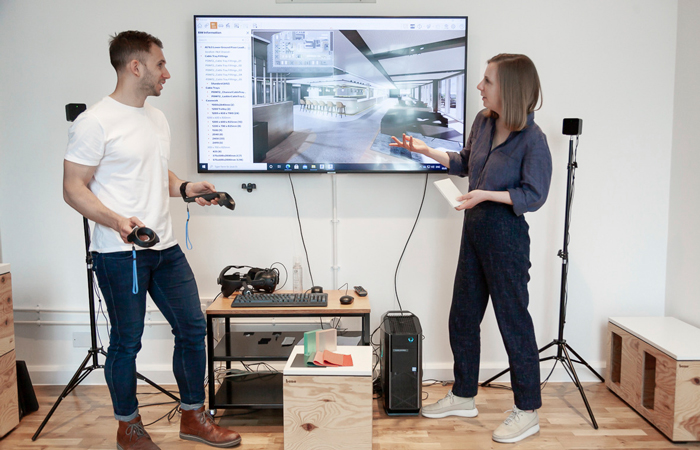
With the integration of AI in design, what are some of the key perspectives or approaches you advocate for in utilising these technologies effectively and responsibly?
I think the human-AI collaboration is critical for a successful future of responsible usage and controlled outcomes. We must balance our design vision with the use of the technology to preserve design integrity.
I’ll always advocate for a tool that helps us to be creative, to think more and do better work, but some of these AI tools are very powerful and require control and restraint. To be truly effective they need good quality data and skilled prompts.
As we continue to explore the integration of generative AI tools into our workflows, we uncover new opportunities and needs to revise our process and expectations. It’s not a linear process of one thing to the next – it often involves combining multiple tools making progress, and then working back through generative AI tools to explore and refine again and again. It’s the ability to dramatically expand the number of opportunities explored before refining and progressing that allows for new ideas to arise.
AI, while promising, brings its own set of challenges and considerations. How do you address these, particularly in terms of design integrity, privacy, and user experience?
Our philosophy for AI in design is that new tools can be great for efficiency and inspiration but should not replace design ownership. Successful interior design is more than just a good-looking space – it’s truly about the substance as well as the style.
The role of the designer as curator and editor of ideas is more important than ever. The ability to create large quantities of content isn’t replacement for critical thinking, human-centered, sustainable and wellness focused design. Defining the charter of a project from a design, performance, and experiential standpoint is critical to ensure that the increased output capacity is focused on the goals.
The legal landscape is still constantly shifting with regards to AI. We’re only just starting to see laws and regulations coming in and who knows what the future may hold. We are doing our best to stay educated on copyright issues, ethical issues and data protection – all very serious matters and tricky ground to navigate!
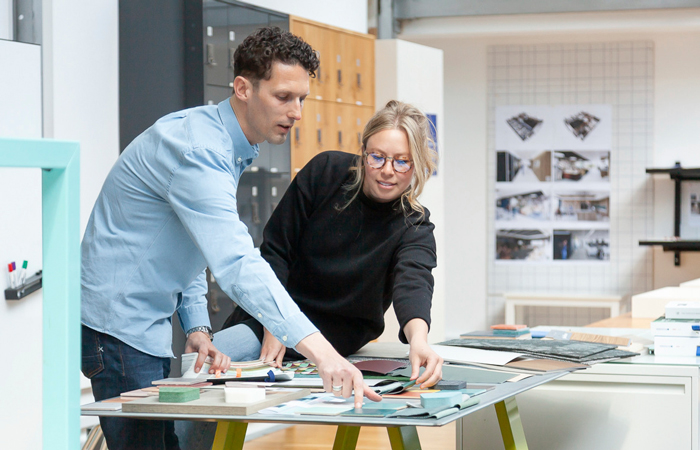
For those in the design community looking to start incorporating AI into their projects, what advice would you give? Are there resources or methodologies you’d recommend exploring?
Just start experimenting! Explore different AI tools, understand their capabilities and find opportunities for your workflow. All of this is so new and it’s changing so fast that it’s hard to do at scale immediately. But if you keep waiting, you’ll be too far behind. Figuring out the right pace of adopting new technologies is the challenging part for us, to make sure the tools we use can be effective and valuable.
I’d also suggest working with specialists who can advise and help you navigate the options. Get up to speed on ethical use and guidelines. And always be honest and transparent about using AI!
How does AI facilitate a more collaborative or innovative approach to workspace design within your team or with clients?
It’s about faster iterations and being able to test ideas quickly. Essentially, we are able to explore more ideas in less time using the tools designers are most comfortable with. The technology enables us to spend more time with analogue processes such as being able to pick up a pen and sit and sketch, or building small models together, rather than having to jump into production mode. We now have tools that can interpret those initial ideas into 3D visuals. However, this doesn’t mean that we should present one hundred options to a client just because we can – the role of the designer is still to carefully curate options and guide our clients to the right solutions.
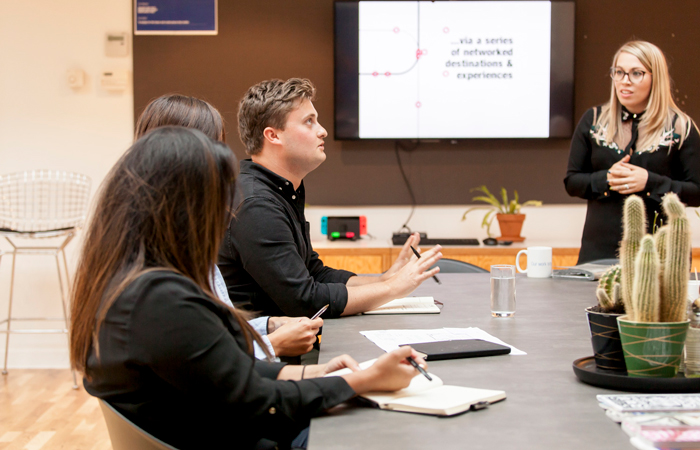
Looking ahead, what are the most exciting possibilities you see for AI in commercial interior design? Are there any specific trends or advancements you’re particularly keen on exploring?
Using technology to optimise resources, expand skillsets and evolve workflows means the industry’s use ofAI will advance at a rapid pace in the next few years.
The ability to understand the relationship between people, technology, and the environment is accelerating with AI tools. Not only will the design process allow for exploring new ideas, but analytic capabilities will be able to provide quantitative and qualitative input on how designs will perform i.e. which approaches will promote wellness, access to light, collaboration, reduce embodied carbon . Whatever metrics are important to designers and clients can be tuned for a given project to guide teams towards projects that are uniquely suited to the end users. This should move us away from generic designs and towards more nuanced solutions with better outcomes for clients and our world.
Finally, as AI continues to evolve, how do you envision its role in shaping the future of workspace design? What are the key factors you believe will influence its impact in the sector?
I hope that AI will help design firms to generate more unique solutions and really showcase their specific design styles or ways of thinking. There’s definitely a danger of homogenising design or making generic projects that all look like a similar blend of images from the internet, but let’s hope that’s not the case!
I also remind myself that AI is not just being used for design – it’s changing the way we do things in the entire world and it will change the entire world of workers too. I imagine in the near future though we’ll be hiring more AI specialists and developing robust frameworks for responsible use.




